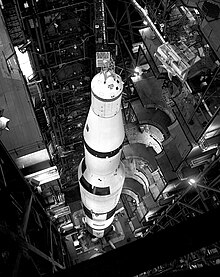Apollo 4
Apollo 4 (November 9, 1967), also known as SA-501, was the uncrewed first test flight of the Saturn V launch vehicle, the rocket that eventually took astronauts to the Moon.
Apollo 4 was an "all-up" test, meaning all rocket stages and spacecraft were fully functional on the initial flight, a first for NASA.
NASA considered the mission a complete success, proving that the Saturn V worked, an important step towards achieving the main objective of landing astronauts on the Moon, and bringing them back safely, before the end of the 1960s.
In 1961 U.S. President John F. Kennedy proposed that his nation land an astronaut on the Moon by the end of the decade, with a safe return to Earth.
In 1962 this was approved by NASA, which contemplated an initial test launch in 1965 and a first crewed flight by 1967, leaving plenty of time to accomplish Kennedy's goal.
[10] In addition to flight-qualifying the hardware, it was necessary to prove that the ground systems at KSC could successfully launch a Saturn V before risking the lives of astronauts on one.
[14] North American Aviation was the contractor for both the S-II Saturn V second stage, and the Apollo command and service module (CSM) spacecraft.
As North American worked to fix the S-II, parts of the rocket began to arrive at KSC, beginning with the S-IVB on August 14, 1966, (by Pregnant Guppy aircraft) and followed closely by the first stage S-IC on September 12 (by barge).
A meeting in March 1967, with Phillips in attendance, disclosed twelve hundred problems with the Saturn V, which the technicians proposed to deal with at the rate of eighty per day.
It was rolled out to LC-39 on August 26, 1967,[14] where it was joined by the Mobile Servicing Structure that allowed access to the launch vehicle and spacecraft two days later, also transported by crawler.
[18] This was the first time a NASA spacecraft had been assembled away from its launch site, something allowing protection from Florida's hot and humid climate for equipment and personnel.
A flight readiness review on October 19 cleared Apollo 4 for launch, assuming the remaining tests and modifications were satisfactorily completed.
The heat shield was upgraded to Block II standards since Apollo 4's high-speed re-entry into Earth's atmosphere was intended to simulate a return from the Moon.
[29] Special equipment had been installed to allow Mission Control to operate the CSM's systems remotely, and there was a camera that would automatically take pictures out of one of the CM's windows on its final orbit.
The LTA consisted of a flight-type descent stage lacking landing gear, with its fuel and oxidizer tanks containing a mixture of water, glycol, and freon.
[35] Mueller, the head of the NASA Office of Manned Space Flight at that time, was a systems engineer who previously worked on military missile projects.
He had recognized that all-up testing was successfully used to rapidly develop the Air Force's Minuteman ICBM program, and thought it could be used to meet Apollo's schedule.
[35] This decision dramatically streamlined the program's test flight phase, eliminating four missions, but it required everything to work properly the first time.
NASA set up press headquarters in Cocoa Beach, where media representatives were accredited, and offered tours of KSC to visiting journalists, as well as a half-hourly shuttle service.
[42] In addition, 43 employees of contractors who had performed in an exemplary manner were selected as "Manned Flight Awareness" honorees, given a VIP tour of KSC, a social evening in which six astronauts participated, and a view of the launch.
[43] Apollo 4, being the first flight of the Saturn V, gained intense media coverage, and writers struggled to convey to the public the size of the launch vehicle, stating that it would tower well over the Statue of Liberty and be thirteen times as heavy.
[44] On the day before launch, Mueller, Phillips, von Braun, Deputy Administrator Robert C. Seamans and Kennedy Space Center Director Kurt Debus[45] held an outdoor press conference for more than a thousand journalists, including some from the Soviet Union, with the Saturn V in the background.
[50] William Donn of Columbia University described the blast as one of the loudest noises, natural or artificial, in human history, excepting nuclear explosions.
[51] CBS's commentator, Walter Cronkite, and producer Jeff Gralnick put their hands on their trailer's observation window to stop it from shattering as ceiling tiles fell from above.
After two orbits, in a simulation of the trans-lunar injection burn that would take later Apollo missions towards the Moon,[53] the S-IVB's first in-space re-ignition put the spacecraft into an elliptical orbit with an apogee of 17,218 kilometers (9,297 nmi) and a perigee deliberately aimed 84.6 kilometers (45.7 nmi) below the Earth's surface; this would ensure both a high-speed atmospheric re-entry of the command module, and destruction after re-entry of the S-IVB.
Shortly after this burn, the CSM separated from the S-IVB and fired its service module engine to adjust the apogee to 18,092 kilometers (9,769 nmi).
They would then be ejected, descend to the Atlantic Ocean in pods with parachutes and radio beacons, and be recovered about 870 kilometers (470 nmi) downrange of KSC.
For a period of two hours and thirteen minutes as the craft approached and passed its apogee, a total of 755 color images were taken through the Command Pilot's (left-hand) forward-looking window, at altitudes ranging from 13,510 to 18,092 kilometers (7,295 to 9,769 nmi).
The CM's environmental control system kept the ship's cabin within acceptable temperatures and pressures throughout the mission, increasing by only 5.6 °C (10 °F) during atmospheric entry.
[43] In his history of the Saturn V, Roger E. Bilstein wrote that "the flawless mission of Apollo 4 elated the entire NASA organization; everyone looked ahead with buoyant spirits.





